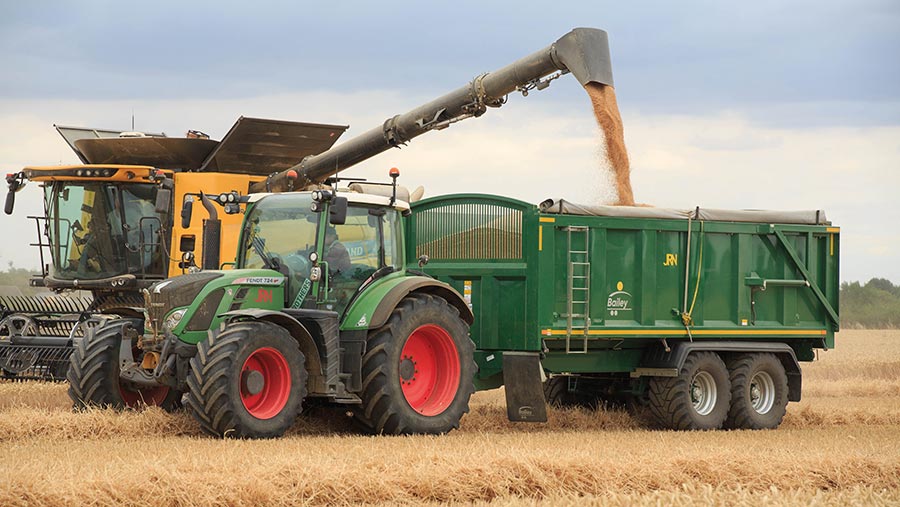14 ways to stay safe this harvest
 © Tim Scrivener
© Tim Scrivener Harvest is often an intense time for farmers and their families, with a dangerous cocktail of long working hours, large machinery and pressure to meet deadlines.
CXCS health and safety adviser Emily Jones shares some simple steps to help ensure farmers come home safe this summer.
See also: Why Lincs grower opted for US-style grain storage system
1. Maintenance
Implement a daily check on vehicles and machinery (to make sure it’s all working correctly and is legal, it’s worth double-checking brakes, lights and indicators on tractors and trailers).
Ask anyone who drives a vehicle to report any damage or defects immediately, so they can be rectified.
2. ‘Safe stop’
Follow the simple protocol of engaging the handbrake, putting the controls in neutral, switching the engine/power off and removing the key before leaving the driver’s seat, when anyone else approaches or before anyone carries out maintenance, adjustments or deals with a blockage.
3. Training
Is everyone who’ll be using machinery, competent and confident? Do they have the relevant qualifications?
Are temporary workers such as students or contractors suitably experienced and qualified and been given the information and training they need?
4 In-cab items
Keep a laminated piece of paper in the cab, ready to put on the seat or the dashboard if you’re working under the machine, telling other people you are there.
Also, keep a first-aid kit in all vehicles.
5. Map
Give anyone unfamiliar with the farm a map showing key safety information, such as overhead power lines, underground cables, public footpaths, areas of sloping ground, bridge strengths and the location of livestock.
6. Lone working
All workers should carry a mobile phone at all times (including when they leave the cab).
Ensure everyone has a list of key contact information, knows the right emergency numbers and phones are always fully charged.
It’s worth downloading the what3words app so you can share your exact location in case of an emergency.
You could also suggest anyone working on their own regularly checks in – via a message on a group chat, for example.
7. On the road
When moving combines and grain carting, be mindful of other drivers as they can be impatient.
Do you have the necessary escort vehicles? Ensure everyone drives in a safe, lawful manner, always observing the highway code.
8. Power lines
Reacquaint yourself with where power lines and poles (and other obstacles) are on the farm.
Also, make sure you look up and do a visual check when entering a field or yard. Should you come into contact with an overhead power line, remain in the cab and warn others in the area to stay well clear.
Call 105. Don’t exit the cab until you have had confirmation it is safe to do so. If you must exit the cab (for example, if the machine catches fire) don’t climb down the steps – you should jump well clear.
Do not touch the machine when you are on the ground as it could be live.
9. Be seen
Wear hi-vis clothing so you can be spotted, and make sure your machines are sufficiently visible, too, by regularly checking lights are working and free of dust and dirt.
10. Fire
In dry periods, keep a water-filled bowser on hand.
Regularly clean dust off vehicles to prevent fires. Always stop to investigate hot-running engines or bearings.
11. Children
Keep youngsters out of yards and anywhere machinery is working or moving.
Know where your children are at all times and explain to them the dangers a farm presents.
12. Fatigue and mental health
When people are struggling, they think less clearly and that’s when mistakes can happen.
Take time to be mindful of your mental health in the run up to – and during – harvest.
Look out for one another. If you are struggling, speak to someone, whether that’s a trusted friend, family member or charity.
There are plenty of resources online, should you need them.
13. Heat and sun
Stay hydrated by drinking lots of water. Avoid too many energy drinks and too much alcohol after work.
Try to eat little and often. Take regular breaks.
Use high-factor sunscreen on exposed skin, wear a hat with a brim and seek shade whenever possible.
14. Pre-harvest prep
Think about yard maintenance ahead of harvest. Can the yard be tidied to remove trip hazards – items that could represent a collision risk – and are there any low-hanging tree branches that could be trimmed to improve visibility?
For more tips on improving safety on your farm, visit the CXCS team on stand 201 at Cereals 2023.
